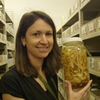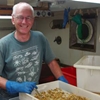Other Names
- Commensal Porcelain Crab
General Description
Carapace much broader than long, with fringe of hairs along frontal margin. Fourth segment (merus) of claws (cheliped) with vestigial lobe; fifth segment (carpus) hairy on inner margin, developed into a prominent, convex lobe, broadest distally and unarmed; claws dorsally hairy. Sixth segment (propodus) of walking legs with more than 12 spinules on lower margin; seventh segment (dactylus) with lower claw larger than upper, with 2 stout spines on lower margin. They are often taken in the paper tubes of the large polychaete Chaetopterus variopedatus and may be living commensally with this species. Up to 11 mm wide.
Biology
This unusual porcelain crab is likely to be seen only in samples of mud dug from the bottom of Port Phillip Bay or similar environments. It lives in a papery tube shared with a large polychaete worm, sometimes in male-female pairs. The dirty, muddy-orange carapace is wider than long and the claws are hairy. Another similar six-legged true crab, Hexapinus granuliferus, has the same preferences.
Habitat
Intertidal, to depths of 24 m.
Soft substrates
Distribution guide
Southern temperate oceans, including southern Australia.
Species Group
Crabs and allies › False crabs
Depth
Shore (0-1 m)
Shallow (1-30 m)
Water Column
Max Size
11 mm
Diet
Organic matter
Harmful
Not harmful but a nip from large claws could be painful
Commercial Species
No
Global Dispersal
Native to Australia
Species Code
MoV 740
Conservation Status
- DSE Advisory List : Not listed
- EPBC Act 1999 : Not listed
- IUCN Red List : Not listed





